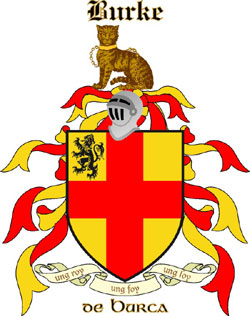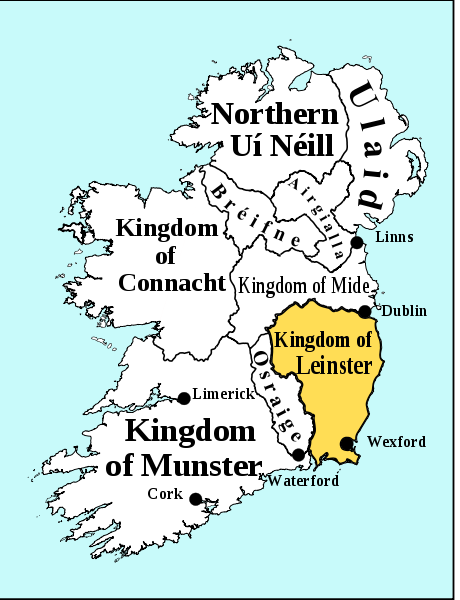
Coat of Arms of the Burke Family

In the history of Galway, Ireland there are 18 families that stand out. The 14 merchant families that came to be called the 14 Tribes of Galway, Athy, Blake, Bodkin, Browne, D'arcy, Deane, Ffont, Ffrench, Joyce, Kirwan, Lynch, Martin, Morris and Skerrit; and 4 other very important none merchant families, O’Flaherty, Birmingham, Burke, and O’Connor.
Page two of this series is about the Athy family one of the 14 tribes of Galway. The Athy’s were credited with erecting the first stone building in Galway. The page shows our direct line of descent from the progenitor of the family in Galway, John de Athy.
This page is about one of the families that is not among the 14 tribes of Galway, but maybe more important in a way, the Burke (Bourke, de Burgh) family. This page shows our direct line of descent from our progenitor in Ireland William de Burgh.
William de Burgh (circa 1160 - winter 1205/1206) was the founder of the de Burgh / Burke / Bourke dynasty in
Ireland. His family descended from the French noble Counts of Rethel and Baldwin II of Jerusalem and he was a direct descendant of Charlemange. William was in England for a while but moved to Ireland in 1185 and was closely associated with Prince John who was the son of King Henry II of England and Eleanor of Aquitaine, and later became John Lackland Plantagenet, King of England. King Henry II of England appointed His son Prince John Lord of Ireland in 1177 and later appointed William Governor of Limerick and granted him vast estates in Leinster and Munster. See map to the right. William was given Connacht and in 1203 took the title "Lord of Connacht", but never had control over it, in fact it seems he never even went into it. That was left up to his |
 |
More information on the family at the bottom of this page.
|
|
King John is our 24th Great-Grandfather. |
|
|
William Marshal, 1st/ 4th Earl of
Pembroke is our 23rd Great-Grandfather. |
|
||
This aside has been to try and illistrate some of the interactions between different branches of our family during this period.
As to Fulk FitzWarin it is very difficult to get at all the truth about his life. The legend of Robin Hood and even his biography, that seems to be embellished, gets in the way. We do know that he had a violent quarrel with King John over his familial right to Whittington Castle in Shropshire. That his lands were appropriated by the King and he was in open rebellion from 1200 to 1203 and had at least 52 men that were with him in his rebellion, many of them his brothers and cousins. That in the spring of 1201, King John ordered Hubert de Burgh (our 26th Great-Granduncle and brother of William de Burgh. Hubert was the most powerful man in England next to King John.) with 100 knights to counter the rebellion of Fulk and William Marsh. Marsh was a Somersetshire knight who was raiding off the coast of Devon. That on 11 Nov 1203, Fulk and over thirty men were pardoned including his brothers William, Phillip and John as well as his cousins. That in October 1204 Fulk received Whittington Castle in "right and inheritance" on payment of a fine of 200 marks. That Fulk was highly regarded by many of the barons and very populer amongst the people.
But, as to Maud's involvement in all of this it seems highly doubtful, as she was still married to her first husband Theobald Walter, 1st Baron Butler and was in Ireland during this time. She did not return to England until after Theobald's death in 1206 and Maud did not marry Fulk until October 1207. But, she was well liked by the people and any good legend needs a little romance in it.
Now back to the Burke family.

William de Burgh, Lord of Connaught
|
Richard Mor (the Great) de Burgh, Lord of Connacht
|
Walter de Burgh, Earl of Ulster
|
Richard the Red Earl de Burgh, 3rd Earl de Burgh, 3rd Earl of Ulster
|
|
William the Brown Earl de Burgh, Earl of Ulster
|
|
Phillippa of Ulster Plantagenet, Countess of Ulster
|
|
Henry Percy, 2nd Earl of Northumberland
|
Henry Percy, 3rd Earl of Northumberland
|
|
Margaret Gascoigne, Baroness Ogle
|
|
|
|
|
|
|
|
|
|
_________|_________
| |
Deacon Thomas Chute[2] Samuel Chute[2]
| |
Andrew Chute --Wife-| Mary Chute
| | |
Edward Chute |---->Olive Woodworth
|_________
|
|
|
|
|
|
[1]Isaac Foster emigrated to America with his father Reginald Foster
[2]Benjamin Foster emigrated to Canada along with his wife their daughter Judith and her husband and children.
[3]Olivia Chute, Harriet Saxton and Eugene Glover all emigrated from Canada to the USA
Galway Fort
"Dún Bhun na Gaillimhe ("Fort at the Mouth (bottom) of the Gaillimh") was constructed in 1124, by the King of Connacht, Tairrdelbach Ua Conchobair who was born in 1088 and died in 1156. A small settlement grew up around this fort." Wikipedia
Richard Mor de Burgh, was Justiciar (viceroy) of Ireland and Lord of Trim in County Meath, Lord of Cannacht and though his wife, Giles de Lacy, Earl of Ulster, as well as Williams oldest son. |
|
The walled city in 1651 (North is to the left). The River Corrib is in the foreground, crossed by what is now "O’Briens Bridge", leading to Mainguard Street. |
As the de Burghs became more gaelicised, the merchants of the town, the so called “Tribes of Galway”, pushed for greater control over the walled city. The merchants eventually gaining complete control over the city even to the granting of mayoral status by the English crown in December 1484.
Galway had difficult relations with its Irish neighbors and it showed in a number of ways. One was by a notice that was placed over the west gate of the city, completed in 1562 by Mayor Thomas Óge Martyn , stating
"From the Ferocious O'Flahertys may God protect us"
The troubled relationship also showed in their law. They had a by-law that forbade the native Irish (as opposed to Galway's Hiberno-Norman citizens) unrestricted access into Galway, saying "neither O' nor Mac shall strutte nor swagger through the streets of Galway" without permission.
During the Middle Ages, Galway was ruled by an oligarchy of the fore mentioned fourteen merchant families (They were of mixed origins, variously Norman, Hiberno-Norman, French, Welsh and English, or some combination of the above. Two of the families were Gaelic-Irish).
One of these families is shown on page two of this series, the Athey family.
The merchant families lost much of their power within Galway city after English Parliamentarians took over the Galway Corporation in 1654. Because of the uncertain response to this dilemma by the merchant families, Cromwell's forces referred to them by the derogatory name, "The Tribes of Galway", which they themselves later adopted as a mark of defiance. And today they are know as the 14 tribes of Galway.
The city thrived on international trade, and in the Middle Ages, it was the principal Irish port for trade with Spain and France.
An Aside
In 1477 Christopher Columbus visited Galway, possibly stopping off on a voyage to Iceland or the Faroe Islands. Seven or eight years later, he noted in the margin of his copy of Imago Mundo: (and used it as part of his argument that he could sail west to Cathay.)
“Men of Cathay have come from the west. [Of this] we have seen many signs. And especially in Galway in Ireland, a man and a woman, of extraordinary appearance, have come to land on two tree trunks [or timbers? or a boat made of such?]”
WikipediaSome say that the most likely explanation for these bodies is that they were Inuit swept eastward by the North Atlantic Current.
County Galway Guide-Galway Tribes
Home | Table of Contents |
Charts and Maps | Family History | Data On Family Members web site 2 This web page, Our Direct Line to our 25th Great-Grandfather Richard Mor de Burgh the founder of Galway, produced 30 Mar 2013
![]()

![]()